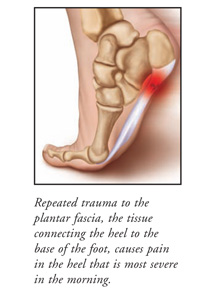 Inflammation of the Plantar Fascia
Inflammation of the Plantar Fascia
Plantar fasciitis is a common cause of heel pain that is more severe in the morning but becomes less painful as the day continues. This condition occurs due to tiny tears in the plantar fascia—the piece of fibrous tissue connecting the heel to the base of the foot. With repeated trauma to the fascia, this tissue cannot heal quickly enough and begins to degenerate. Plantar fasciitis can cause chronic pain if it is not treated. Typical treatment includes rest, anti-inflammatory pain medications, and an exercise program comprising stretching and strengthening the muscles and tendons of the foot and calf. Evaluation of the patient’s shoes may help determine whether improper fitting is leading to this condition. The use of an orthotic during the daytime and foot splints at night may provide relief. If those who suffer from plantar fasciitis do not improve with these treatments, surgery may be a successful option.
A Common Cause of Heel Pain
Plantar fasciitis is the diagnosis in about 15% of all office visits for foot-related pain. Typically, it is not a serious condition and often disappears on its own in six to 18 months; however, simple treatments can lead to improvement in two to three months. In some cases, it can significantly limit a person’s ability to function in routine activities. If left untreated, the symptoms usually worsen and can lead to problems with the knee and hip and can cause back pain due to difficulty walking.
The Pattern of Symptoms
The symptoms of plantar fasciitis develop gradually, beginning with a mild pain in the heel bone after exercise, upon rising from bed in the morning, or after resuming activity following a period of rest. After the pain continues for a period of time, patients often begin to walk with a limp. At first the pain lessens after walking, but eventually it worsens as activity levels increase.
Risk Factors
The people who are most likely to develop plantar fasciitis are those who frequently stand or walk throughout the day or those who walk or run for exercise. Although it is not clear exactly what causes this condition, it seems the problem begins with tiny tears in the plantar fascia from repeated trauma. People who are overweight, those with flat feet or high arches, and women ages 40 to 60 are at greater risk for this condition.
Self-Care Measures
The primary treatment is rest. Most people suffering from plantar fasciitis find relief, at least in part, by staying off their feet whenever possible. Some patients find that cold packs applied to the area for 20 minutes several times a day or after activities give some relief. In addition, most doctors recommend over-the-counter pain medications, such as nonsteroidal antiinflammatory drugs (ibuprofen or naproxen) to help manage the pain. When the condition is first diagnosed, the patient should have a shoe check to determine if improperly fitting shoes are causing or worsening the problem. Patients are often advised not to walk on hard surfaces and not to go barefoot. Shoes should be well cushioned, especially in the midsole area, and should have the appropriate arch support for the patient. Some patients will benefit from an orthotic shoe insert, such as a rubber heel pad for cushioning. Most patients are also given a series of stretching and strengthening exercises to help keep the muscles active and flexible and to avoid future bouts of this painful condition.
If the Condition Persists
Patients who do not find relief with these simple treatments within two to three months may be given a local injection of cortisone. Nighttime splints may help keep the fascia properly flexed during sleep, making the first steps in the morning much less painful. Some patients benefit from a walking cast for use during the daytime for several weeks. A last resort is to undergo surgery to release the plantar fascia by one of several techniques. This surgery is usually successful in a high percentage of the patients who are unable to find relief from less invasive treatments.






